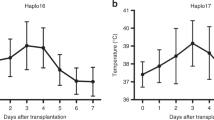Abstract
The optimal time for starting G-CSF application after autologous peripheral stem cell transplantation (APSCT) still remains undetermined. All previous studies used ‘fixed’ days (0 or +1 vs +5 or +7 post-transplant) for this purpose. As many other drugs have individual, patient-dependent criteria (eg antibiotics, blood products, etc), and the discontinuation of G-CSF also has strict patient-dependent criteria (surprisingly absent when starting the drug) we suppose that attempts to find general criteria suitable for every patient may not be successful. In order to also take the patients’ individual predispositions into account we designed a randomized clinical trial to compare ‘immediate’ administration of G-CSF (day +1: group A) vs ‘delayed, patient-dependent’ (first day when absolute neutrophil count (ANC) was below 0.5 × 109/l: group B) therapy with G-CSF (both groups received 10 μ g/kg/day i.v.). A total of 70 patients after APSCT suffering from non-Hodgkin’s lymphoma (NHL) and Hodgkin’s disease (HD) conditioned with BEAM, or from multiple myeloma (MM) after melphalan (L-PAM: 200 mg/m2) were enrolled in this study (35 in each group). Both groups were comparable with regard to age, sex, disease stage and previous therapy as well as the number of CD34+ cells transplanted. In group B, G-CSF administration began on day +4 post-transplant (+2 – +5). There were no detectable differences seen in the hematopoietic recovery (time to reach ANC more than 0.5 × 109/l: 12 days vs 13 days; time to platelet recovery, more than 50 × 109/l: 24 days in both groups), use of blood products or antibiotics, infections, or days of hospitalization. Delayed G-CSF application led to significant cost saving in terms of APSCT (approximately US$1341 for each patient). We suggest that ‘patient-dependent’ criteria for starting G-CSF are reasonable especially in patients conditioned with protocols only slowly inducing neutropenia: eg NHL and HD patients after BEAM, MM after L-PAM or patients after busulphan and cyclophosphamide (BUCY2).
This is a preview of subscription content, access via your institution
Access options
Subscribe to this journal
Receive 12 print issues and online access
$259.00 per year
only $21.58 per issue
Buy this article
- Purchase on Springer Link
- Instant access to full article PDF
Prices may be subject to local taxes which are calculated during checkout
Similar content being viewed by others
Author information
Authors and Affiliations
Rights and permissions
About this article
Cite this article
Cetkovský, P., Koza, V., Jindra, P. et al. Individual criteria could be optimal for starting G-CSF application after autologous stem cell transplantation. Bone Marrow Transplant 20, 639–641 (1997). https://doi.org/10.1038/sj.bmt.1700947
Received:
Accepted:
Issue Date:
DOI: https://doi.org/10.1038/sj.bmt.1700947
Keywords
This article is cited by
-
Optimal use of G-CSF administration after hematopoietic SCT
Bone Marrow Transplantation (2009)
-
G-CSF or not G-CSF? That is the question
Bone Marrow Transplantation (2004)
-
A randomized, multicenter study of G-CSF starting on day +1 vs day +5 after autologous peripheral blood progenitor cell transplantation
Bone Marrow Transplantation (2002)
-
Causative factors for prolonged hospitalization beyond the point of engraftment in patients after autologous peripheral blood stem cell transplantation
Bone Marrow Transplantation (2000)



